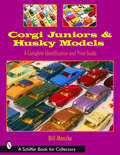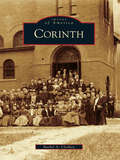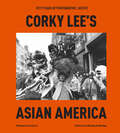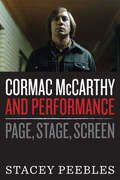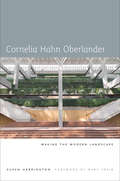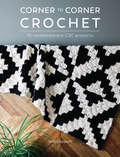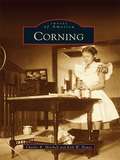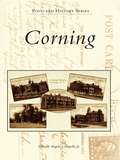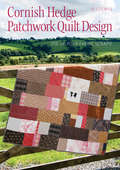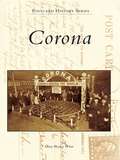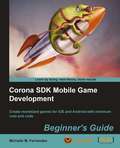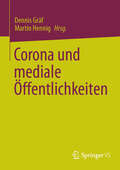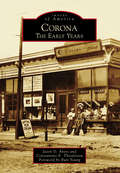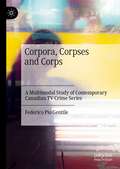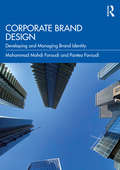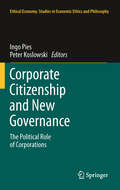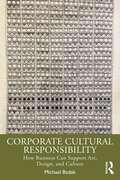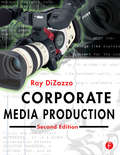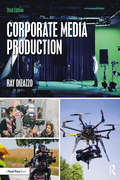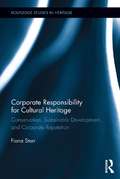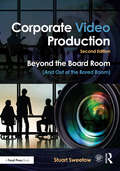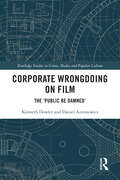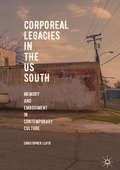- Table View
- List View
Corgi Juniors & Husky Models: A Complete Identification and Price Guide
by Bill ManzkeCorgi Juniors and Husky Models brings together the story of these small-scale model cars and other toys into one book for the first time. Once the #3 brand in many markets, they competed head-to-head with Mattel's Hot Wheels cars and Lesney's Matchbox Series. This widely collected line of diecast toy cars and trucks are examined in every detail. Over 500 full color photos and well-researched text presents the entire history of these cars, from the introduction of Husky Models in 1964, to the Corgi Classics of today. Here are Corgi Juniors, Corgi Rockets, Husky Toys, Whizzwheels Conversions and many more. The text includes never before published information on prototype, pre-production, and promotional models. An extensive section of variation listings, and details on every known model. The alphabetical cross-reference section provides readers with easy access to model numbers and current values.
Corinth (Images of America)
by Rachel A. ClothierCorinth's name, selected from the Bible, was chosen when the township was first incorporated in 1818. Situated perfectly to benefit from the surrounding natural resources, Corinth has a long history as a mill town, processing timber, wool, and grains using the power of the Hudson River. Located at the northern edge of Saratoga County, Corinth has been both a rural agricultural community and an industrial center. It is home to several churches, community organizations, and businesses, as well as one of International Paper's largest mills, which used the Hudson for both transportation and energy generation. Within Corinth, readers will discover the area's past through images of mill workers, schoolchildren, farmers, shopkeepers, and other residents, as well as the homes and businesses they built.
Corky Lee's Asian America: Fifty Years of Photographic Justice
by Corky LeeA collection of over 200 breathtaking photos celebrating the history and cultural impact of the Asian American social justice movement, from a beloved photographer who sought to change the world, one photograph at a time &“For generations, Corky taught us how to see ourselves—as individuals and as a community.&”—Hua Hsu, Pulitzer Prize-winning author of Stay TrueKnown throughout his lifetime as the &“undisputed, unofficial Asian American photographer laureate,&” the late photojournalist Corky Lee documented Asian American and Pacific Islander communities for fifty years, breaking the stereotype of Asian Americans as docile, passive, and, above all, foreign to this country. Corky Lee&’s Asian America is a stunning retrospective of his life&’s work--a selection of the best photographs from his vast collection, from his start in New York&’s Chinatown in the 1970s to his coverage of diverse Asian American communities across the country until his untimely passing in 2021. Corky Lee's Asian America traces Lee&’s decades-long quest for photographic justice, following Asian American social movements for recognition and rights alongside his artistic development as an activist social photographer. Iconic photographs feature protests against police brutality in New York in the 1970s, a Sikh man draped in an American flag after 9/11, and a reenactment of the completion of the transcontinental railroad of 1869 featuring descendants of Chinese railroad workers, and his last photos of community life and struggle during the coronavirus pandemic. Asian American writers, artists, activists, and friends of Lee reflect on his life and career and provide rich historical and cultural context to his photographs, including a foreword from writer Hua Hsu and contributions from artist Ai Weiwei, filmmaker Renée Tajima-Peña, writer Helen Zia, photographer Alan Chin, historian Gordon Chang, playwright David Henry Hwang, and more.Featuring never-before-seen photographs alongside his best-known images, Corky Lee&’s Asian America represents Lee&’s mission to chronicle a history of inclusion, resistance, ethnic pride, and patriotism. This is a remarkable documentation of vital moments in Asian American history and a timely reminder that it&’s also a history that we continue to make.
Cormac McCarthy and Performance: Page, Stage, Screen
by Stacey PeeblesCormac McCarthy is renowned as the author of popular and acclaimed novels such as Blood Meridian, All the Pretty Horses, and The Road. Throughout his career, however, McCarthy has also invested deeply in writing for film and theater, an engagement with other forms of storytelling that is often overlooked. He is the author of five screenplays and two plays, and he has been significantly involved with three of the seven film adaptations of his work. In this book, Stacey Peebles offers the first extensive overview of this relatively unknown aspect of McCarthy&’s writing life, including the ways in which other artists have interpreted his work for the stage and screen. Drawing on many primary sources in McCarthy&’s recently opened archive, as well as interviews, Peebles covers the 1977 televised film The Gardener&’s Son; McCarthy&’s unpublished screenplays from the 1980s that became the foundation for his Border Trilogy novels and No Country for Old Men; various successful and unsuccessful productions of his two plays; and all seven film adaptations of his work, including John Hillcoat&’s The Road (2009) and the Coen brothers&’ Oscar-winning No Country for Old Men (2007). Emerging from this narrative is the central importance of tragedy—the rich and varied portrayals of violence and suffering and the human responses to them—in all of McCarthy&’s work, but especially his writing for theater and film.
Corn Palaces and Butter Queens: A History of Crop Art and Dairy Sculpture
by Pamela H. SimpsonTeddy Roosevelt&’s head sculpted from butter. The Liberty Bell replicated in oranges. The Sioux City Corn Palace of 1891 encased with corn, grains, and grasses and stretching for two city blocks—with a trolley line running down its center. Between 1870 and 1930, from county and state fairs to the world&’s fairs, large exhibition buildings were covered with grains, fruits, and vegetables to declare in no uncertain terms the rich agricultural abundance of the United States. At the same fairs—but on a more intimate level—ice-cooled cases enticed fairgoers to marvel at an array of butter sculpture models including cows, buildings, flowers, and politicians, all proclaiming the rich bounty and unending promise held by the region.Often viewed as mere humorous novelties—fun and folksy, but not worthy of serious consideration—these lively forms of American art are described by Pamela H. Simpson in a fascinating and comprehensive history. From the pioneering cereal architecture of Henry Worrall at the Philadelphia Centennial Exposition to the vast corn palaces displayed in Sioux City, Iowa, and elsewhere between 1877 and 1891, Simpson brings to life these dazzling large-scale displays in turn-of-the-century American fairs and festivals. She guides readers through the fascinating forms of crop art and butter sculpture, as they grew from state and regional fairs to a significant place at the major international exhibitions. The Minnesota State Fair&’s Princess Kay of the Milky Way contest, Lillian Colton&’s famed pictorial seed art, and the work of Iowa&’s &“butter cow lady,&” Norma &“Duffy&” Lyon, are modern versions of this tradition. Beautifully illustrated with a bounty of never-before-seen archival images, Corn Palaces and Butter Queens is an accessible history of one of America&’s most unique and beguiling Midwestern art forms—an amusing and peculiar phenomenon that profoundly affected the way Americans saw themselves and their country&’s potential during times of drought and great depression.
Cornelia Hahn Oberlander: Making the Modern Landscape
by Marc Treib Susan HerringtonCornelia Hahn Oberlander is one of the most important landscape architects of the twentieth century, yet despite her lasting influence, few outside the field know her name. Her work has been instrumental in the development of the late-twentieth-century design ethic, and her early years working with architectural luminaries such as Louis Kahn and Dan Kiley prepared her to bring a truly modern--and audaciously abstract--sensibility to the landscape design tradition. In Cornelia Hahn Oberlander: Making the Modern Landscape, Susan Herrington draws upon archival research, site analyses, and numerous interviews with Oberlander and her collaborators to offer the first biography of this adventurous and influential landscape architect. Born in 1921, Oberlander fled Nazi Germany at the age of eighteen with her family, going on to become one of the few women to graduate from Harvard University's Graduate School of Design in the late 1940s. For six decades she has practiced socially responsible and ecologically sensitive planning for public landscapes, including the 1970s design of the Robson Square landscape and its adjoining Provincial Law Courts--one of Vancouver's most famous spaces. Herrington places Oberlander within a larger social and aesthetic context, chronicling both her personal and professional trajectory and her work in New York, Philadelphia, Vancouver, Seattle, Berlin, Toronto, and Montreal. Oberlander is a progenitor of some of the most significant currents informing landscape architecture today, particularly in the area of ecological focus. In her thorough biography, Herrington draws much-deserved attention to one of the truly important figures in landscape architecture.
Corner to Corner Crochet: 15 Contemporary C2C Projects
by Jess CoppomCorner to corner crochet--also known as C2C crochet--is the perfect way to create colourful, graphic designs without having to learn complex colourwork techniques. Using basic crochet stitches you can create stunning, contemporary designs for home decor items and accessories. C2C projects also stitch up super-fast so if you've been put off tackling a crochet blanket because it would take too long, this is the technique for you! Author Jess Coppom has brought a really fresh take to this style of crochet with a collection of 15 modern projects all made using the C2C technique. Choose from patterns for six different afghans or blankets including a monochrome chunky throw and a beautiful Mexican style blanket. Other projects include pillows, a bathroom rug and some stunning items to wear such as a poncho, shawl and cowl. Why not make some C2C projects for yourself and then stitch up some treats for friends and family?
Corning
by Kirk W. House Charles R. MitchellLenses for railroad lanterns, cut glass for the White House table, Thomas Edison's first light bulb-the glass for all of these was made in Corning, the glass capital of America, the Crystal City. From 1880 to World War I, newfound wealth sparked a spending and building boom that shaped the city. Corning recaptures the city's gilded age, the boom days when tax-free fortunes could be made-and lost-overnight. Vintage photographs show elephants and buffalo parading down Market Street, the Drake family giving recitals on its home pipe organ, churches and public buildings rising, carriages giving way to motorcars, and huge summer homes springing up on the Finger Lakes.
Corning
by Donald Angelo Carapella Jr.In the 1830s, when a feeder branch of the Erie Canal linked up with the Cheumung River, Corning first became connected to the rest of the world. By the 1880s, Corning had become a railroad town with trains going in all directions. Industrial growth in the 1890s led to the rise of businesses and factories, such as Corning Glass Works. Because Corning produced so much glass, it became known as the crystal city and grew into a tourist destination. A town with many accomplishments, Corning was once home to a minor-league baseball team and is the birthplace of Margaret Sanger, a birth control activist who founded the American Birth Control League, which became Planned Parenthood. From the 1890s until the 1960s, the growth of the community's businesses, parks, churches, and recreation were captured in postcards, many never published before.
Cornish Hedge Patchwork Quilt Design
by Jo ColwillThis stunning quilt was inspired by quilting expert Jo Colwill's life on her Cornish farm. The sewing techniques are clearly described to help you to achieve professional results with step-by-step instructions, detailed diagrams and clever tips and tricks to help you along the way! Project taken from Cushions & Quilts by Jo Colwill
Corona
by Mary Bryner WinnSeveral times in the late 20th century, Corona was cited as the fastest-growing city in California, doubling and tripling its former sleepy-town size of around 25,000 in the 1970s to 150,000 in a matter of just decades. Corona has come a long way from its former offshoot identity as South Riverside in the late 19th century. Incorporated as Corona in 1896, itsurvived as a dry-farming community until the arrival of citrus crops. Its status as a way station for travelers between Los Angeles and the outlying desert communities was dramatically altered in the mid-1910s when it became an internationally recognized road-racing draw for the likes of Barney Oldfield and other great speedsters of the day. As abedroom community today for workers in Orange and Los Angeles Counties, it is virtually a prototype of Southern California suburban growth.
Corona SDK Mobile Game Development: Beginner's Guide
by Michelle M. FernandezYou will learn by doing. First a brief crash course in Lua and Corona. Once this is done you will be thrown straight into creating fully functional complete games chapter by chapter. Certain chapters are reserved for adding advanced features such as multiple device integration, social networking and monetization. This book is for anyone who wants to have a go at creating commercially successfully games for Android and iOS. You don't need game development or programming experience.
Corona und mediale Öffentlichkeiten
by Martin Hennig Dennis GräfDieses Buch bietet einen umfassenden, interdisziplinären Blick auf mediale Erscheinungsformen im Kontext der Corona-Krise und fokussiert in diesem Zusammenhang insbesondere medien- und kommunikationswissenschaftliche, linguistische und philosophische Perspektiven auf die öffentliche Kommunikation zum Themenfeld des Coronavirus. Gerade zu Beginn der Corona-Krise kam es aufgrund der aus der Neuartigkeit des Coronavirus resultierenden Ungewissheit zu signifikanten kommunikativen Störmomenten, deren Rekapitulation und Analyse für eine demokratische Gesellschaft unabdingbar sind. In diesem Sinne forscht dieses Buch nach den kommunikativen Mustern des öffentlichen Sprechens über das Coronavirus in fiktionalen sowie nicht-fiktionalen Formaten.Konkret werden im Rahmen der nicht-fiktionalen Formate TV-Nachrichtensendungen, TV-Talkshows und TV-Dokumentationen, Printnachrichten sowie Social Media-Posts analysiert. Im Rahmen der fiktionalen Formate stehen v.a. Online-Serien im Fokus des Interesses. Die unterschiedlichen, sich aus der Interdisziplinarität des Bandes ergebenden methodischen Zugänge ermöglichen einen breit gefächerten, polyperspektivischen Zugang zur Corona-Kommunikation und lassen gleichwohl (medien-)übergreifende diskursive Muster - als ein signifikantes Ergebnis des Sammelbandes - erkennen.
Corona: The Early Years (Images of America)
by Jason D. Antos Burt Young Constantine E. TheodosiouNestled between old Newtown (today's Elmhurst) and the village of Flushing in the borough of Queens lies Corona. Blessed with an enchanting landscape, the area attracted development as early as 1854, when the West Flushing Land Company sought to create a suburban residential neighborhood in its midst. For Corona's cherished way of life, represented by Colonial-era farms, dirt roads, and gaslight streetlamps, this marked a distinct break from the past. Developer Benjamin Hitchcock's novel installment-plan system had helped place Corona on the map for good by 1870, laying down a historical precedent for later communities like Forest Hills and Jackson Heights to take shape. Before Mets baseball and the US Open were fixtures on the local scene, New Yorkers flocked to the National Race Course, one of the first such complexes in the entire country, for an exciting day at the races. Meanwhile, in its Corona-based factory, the Tiffany Glass Company forged distinctive lamps and glassware that in time would become world famous.
Corpora, Corpses and Corps: A Multimodal Study of Contemporary Canadian TV Crime Series
by Federico Pio GentileThis book uses corpus and multimodal methods to present a comparative study of three major Canadian TV crime series, Flashpoint (2008-2010), Motive (2013-2015) and 19-2 (2014-2016), paying special attention to cinematic techniques. Following an overview of the methodology and the Canadian cultural milieu of the study, the author approaches the three series as complex cultural and linguistic productions that depend heavily on a national appropriation of a genre whose popularity is growing internationally. The book investigates the verbal, nonverbal and paraverbal strategies employed by each production to create the patterns that make this genre appealing to a variety of audiences, and uncovers some of the psychological processes at work in contemporary Canadian TV crime serials. This book will be of interest to scholars in fields including Corpus Linguistics, Multimodal Studies, Canadian Studies, Media and Communication Studies, and Specialised Discourse.
Corporate Brand Design: Developing and Managing Brand Identity
by Pantea Foroudi Mohammad Mahdi ForoudiCorporate Brand Design offers a unique and comprehensive exploration of the relationship between companies, their brand design, and their stakeholders. The book begins its approach with a literature review, to provide an overview of current thinking on the subject and establish a theoretical framework. The following sections cover key stages during the corporate brand development process: Brand signature design, its components and impact on brand reputation; website design and how it builds customer perception of the brand; corporate architecture design and the branding of space and place; brand experience design from a sensuality perspective. International case studies from a range of industries feature in each chapter to demonstrate how the theory translates to practice, alongside case questions to cement learning and definitions of the key constructs. By combining academic theory with practical case studies and examples, readers will gain a thorough understanding of the corporate brand design process and how it influences customer identification and loyalty to the brand. The book is a useful resource for advanced undergraduate and postgraduate students of strategic brand management, corporate brand design and visual identity, and marketing communications.
Corporate Citizenship and New Governance: The Political Role of Corporations (Ethical Economy #40)
by Peter Koslowski Ingo PiesThis volume unites the perspective of business ethics with approaches from strategic management, economics, law, political science, and with philosophical reflections on the theory of Corporate Citizenship and New Governance. In view of the internationalization of the (global) economy and the free movement of capital, new instruments of political coordination are needed. These societal changes trigger the two closely intertwined challenges examined in this book. The first challenge relates to the role and the self-conceptualization of business firms as corporate citizens within society. Companies are increasingly expected to assume the social responsibility of helping to shape the rule-framework of globalization. The second challenge refers to the form of the engagement in local, national and international processes of governance. To more credibly and effectively tackle these challenges, corporate actors are ever more participating in rule-setting processes together with civil society organizations and the government.
Corporate Cultural Responsibility: How Business Can Support Art, Design, and Culture
by Michael BzdakIs corporate investing in the arts and culture within communities good business? Written by an expert on the topic who ran the Corporate Art Program at Johnson & Johnson, the book sets out the case for business patronage of the arts and culture and demonstrates how to build an effective program for businesses to follow. As companies seek new ways to add value to society, this book places business support of the arts in a corporate social responsibility context and offers a new concept: Corporate Cultural Responsibility. It discusses the issues underlying business support of the arts and explores new avenues of collaboration and value creation. The framework presented in the book serves as a guide for identifying the key attributes and projected impact of successful and sustainable models. Unlike other books centered on the relationship of art and commerce, this book looks at the broader and global implications of Corporate Cultural Responsibility. It also usefully sets the discussion about the role of philanthropy and corporate social responsibility and the arts within an historical timeframe. As the first book to link culture to community responsibility, the book will be of particular relevance to corporate art advisors and auction houses, as well as students of arts management and corporate social responsibility at advanced undergraduate and postgraduate levels.
Corporate Media Production
by Ray DiZazzoWith the advent of affordable equipment, there are more opportunities than ever in the field of corporate media production. This book examines all aspects of this creative field, from concept development to the final stages of postproduction. The book also clarifies the roles of the writer, producer, director and client while focusing on the dynamics among these key players. This in-depth book captures all the technical and creative elements used in the creation of media in the corporate world. The new edition has been updated to reflect the most current media production, editing, delivery formats and processes, with an emphasis on DV. There is material on the new digital video cameras and non-linear editing systems, as well as an expanded discussion of audio sweetening. A new chapter on evaluation demystifies this critical process, and there is a new discussion of multimedia.
Corporate Media Production
by Ray DizazzoThis book offers an in-depth exploration of the exciting field of corporate media production from concept development through to the final stages of postproduction and considers all the technical, interpersonal and creative elements needed for success. This third edition has been updated to reflect both traditional and social media production perspectives, including all phases of research and script development/presentation; essential preproduction activities and production styles; equipment; editing; distribution and evaluation methods; and the role of social media as distribution platforms. Special emphasis is placed on the director’s role and client education and handling. Organized to follow the standard production sequence, Corporate Media Production, Third Edition, will lead students through the entire process in a clear, logical, step-by-step manner. Topics include: Program needs analysis Client interaction Critical judgment and people skills The director’s role Script essentials Dialogue and narration Audio production Editing Social media production and distribution Written in an engaging and easy-to-follow format, this book is a perfect introduction for students wanting to learn the ins and outs of corporate media production.
Corporate Responsibility for Cultural Heritage: Conservation, Sustainable Development, and Corporate Reputation
by Fiona StarrThis book examines the relationship between two divergent fields – corporate activity and heritage conservation – linking the financing of conservation and its benefits with the corporate social responsibility (CSR) goals of the private sector. Through discussion of physical conservation, benefits to heritage site visitors, sustainable development impacts, and corporate benefits such as improved reputation, this book outlines the shared value of corporate support for cultural heritage sites, and encourages financial and in-kind support for conservation and responsible activity by the private sector. Providing a convincing commercial rationale for CSR managers to engage with cultural heritage sites, this book suggests how companies may reap the benefits of CSR for heritage. Author Fiona Starr offers advice for companies looking to specialize in a unique CSR endeavor, especially those looking to engage with emerging markets. The book also provides useful strategies for heritage managers to attract CSR and financial support, offering new look at the financing of heritage conservation at both international and local levels and providing a new approach to the future of financing of cultural heritage conservation
Corporate Video Production: Beyond the Board Room (And Out of the Bored Room)
by Stuart SweetowIn this updated edition of Corporate Video Production, Stuart Sweetow teaches aspiring and seasoned videographers how to make imaginative corporate videos with eye-catching designs, rhythmic editing tricks, and essential scriptwriting and interview techniques. Readers will learn how to shoot on location or in a studio, work with employees-turned-actors, find new clients, and produce online videos and podcasts for corporations, government agencies, and non-profit organizations. Additionally, this new edition has been updated to include discussion questions, chapter summaries, and professional tips, and to cover live webcasting, mobile devices, shooting in 4K, micro-videos, micro-cameras, and storytelling techniques for corporate social responsibility programs. A companion website features downloadable forms and further resources.
Corporate Wrongdoing on Film: The ‘Public Be Damned’ (Routledge Studies in Crime, Culture and Media)
by Kenneth Dowler Daniel AntonowiczCorporate Wrongdoing on Film: The ‘Public Be Damned’ provides a unique and ground-breaking analysis of corporate wrongdoing depictions, identifying, describing, and categorizing harms perpetrated by corporations. The book provides a history of corporate wrongdoing in film, from the silent film to the present day. Early films are summarized and discussed within the historical, social and political contexts in which they were released. Examining films produced after 1979, the book classifies them by corporate harms to the environment, workers, consumers, and the economy. The book includes a discussion of well over 100 films, from obscure television movies to Hollywood blockbusters. Finally, the book concludes with a narrative analysis exploring the depiction of the protagonists, antagonists, and victims within the corporate wrongdoing film. Detailed and accessible, Corporate Wrongdoing on Film: The ‘Public Be Damned’ will be of great interest to scholars and students of Criminology and Film and Media Studies.
Corporeal Legacies in the US South: Memory And Embodiment In Contemporary Culture
by Christopher LloydThis book examines the ways in which the histories of racial violence, from slavery onwards, are manifest in representations of the body in twenty-first-century culture set in the US South. Christopher Lloyd focuses on corporeality in literature and film to detail the workings of cultural memory in the present. Drawing on the fields of Southern Studies, Memory Studies and Black Studies, the book also engages psychoanalysis, Animal Studies and posthumanism to revitalize questions of the racialized body. Lloyd traces corporeal legacies in the US South through novels by Jesmyn Ward, Kathryn Stockett and others, alongside film and television such as Beasts of the Southern Wild and The Walking Dead. In all, the book explores the ways in which bodies in contemporary southern culture bear the traces of racial regulation and injury.
Corporeal Politics: Dancing East Asia (Studies in Dance History Series)
by Emily Wilcox Katherine MezurIn Corporeal Politics, leading international scholars investigate the development of dance as a deeply meaningful and complex cultural practice across time, placing special focus on the intertwining of East Asia dance and politics and the role of dance as a medium of transcultural interaction and communication across borders. Countering common narratives of dance history that emphasize the US and Europe as centers of origin and innovation, the expansive creativity of dance artists in East Asia asserts its importance as a site of critical theorization and reflection on global artistic developments in the performing arts. Through the lens of "corporeal politics"—the close attention to bodily acts in specific cultural contexts—each study in this book challenges existing dance and theater histories to re-investigate the performer's role in devising the politics and aesthetics of their performance, as well as the multidimensional impact of their lives and artistic works. Corporeal Politics addresses a wide range of performance styles and genres, including dances produced for the concert stage, as well as those presented in popular entertainments, private performance spaces, and street protests.
